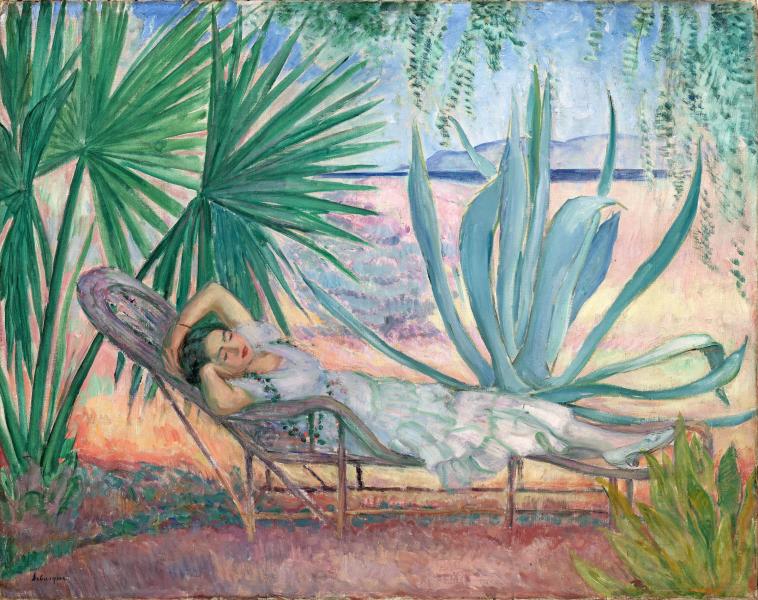Saint Tropez, le hamac sous les pins, 1923
Oil on canvas, signed lower left.
73 x 91.30 cm
Provenance:
Galeries Georges Petit, Paris, February 1923
Moudon sale, Lausanne, April 1, 1965, no. 97
Germann sale, Zurich, November 28, 1974, no. 143
Private collection, Switzerland Sale Koller, Zurich, June 24, 2011, n°3222
Walid Juffali Collection, London
Bonhams sale, London, March 1, 2018
Private collection, Netherlands
Bibliography :
Denise Bazetoux, Henri Lebasque, Catalogue raisonné, Tome I, 2008, reproduced in black and white as n°1217 p.299.
Exhibitions :
Stockholm French Art Exhibition, Galeries Georges Petit, Paris, February 1923
Autumn French Exhibition, Compagnie Franco-Japonaise, Asahi-Shimbun building, Tokyo, November 1927.
A SIESTA IN ARCADIA
From his ancestry in Anjou, his grandparents farmers and his father a lumber merchant, Lebasque has retained a fundamentally sylvan soul. He has little tolerance for cities, even from a strictly physical point of view, having suffered from rheumatism since his youth. The South, with its warmth and light, held a special attraction for the man, and even more so for the painter.
It was in 1906 that he discovered the southern coast, staying at the Villa Demière in Saint-Tropez on the advice of his friend Manguin. It was to remain his lifelong love affair. Every year, when the weather was fine, he would spend several months there, sometimes in Sanary (1911), Nice (1913), Sainte-Maxime (1914), Cannes (1918), Saint-Tropez again (1920), even going as far as Collioure the following year, then Le Pradet (1923), before settling more permanently in the Cannes area.
In 1895, Lebasque married, and his wife took on an additional role in the couple: that of model. She first posed in the Parisian apartment of their first years of marriage, then allowed herself to be painted during country outings in the Marne, while Lebasque's doctors advised him to leave Paris, which was harmful to him.
The union was soon strengthened by the birth of children, providing Lebasque with daily family inspiration. Marthe and Nono, the two darling children, are in the garden with their mother, sewing, reading, simply posing, counting the rosaries of infinite benevolence for the painter. Pierre, the youngest, sometimes joins them, with the bonhomie of early childhood.
Such is the life of Lebasque's paintings: in sunny gardens with lush vegetation, smiling episodes of family prosperity. Life on earth, however, is not like this, and the painter suffers from recurring health and financial problems. Lebasque is certainly not a theorist, but he is a hard-working man, even if we can't guess at the effort he puts into his work under the light pink and mauve mists of the eternal Mediterranean summer.
Hélène, Nono, takes a nap by the sea, on a chaise longue framed by a palm tree and agaves, an exotic setting worthy of a Garden of Eden, in this painting, which was exhibited at the Galerie Georges Petit in early 1923.
In the background, the Gulf of Saint-Tropez is revealed, the sea like a blue leash more pronounced than the hill, emerging at the edge of the dreamer's daydreams. With her eyes closed and her arms folded above her head, the wise odalisque is dressed in a ruffled, summery white dress, with her pumps still on.
This modesty immediately distances him from it, yet the composition and motif are reminiscent of a canvas painted by Matisse around the same time and recently sold as part of the Rockefeller collection's dispersal. L'odalisque couchée aux magnolias, painted in 1923, shows a reclining woman in the same position, except that this one is largely undressed. In Matisse's work, the vegetal background is also present, but feigned: this is an interior scene, and against the background of the magnolia bouquet, the foliage surrounding the model is that of wallpaper.
Matisse and Lebasque, two lovers of the South, each evoked in their own way, in a very different style and palette, the joy of living in the southern light.
Lebasque shares more in common with Bonnard, and with certain Nabis, united in this adoration of the intimacy of the home, which has become the center of the world, the center of inspiration. But Lebasque takes this intimacy outside, presenting it to the Mediterranean sun. He doesn't overexpose it, of course; he shelters it under arbors and large, benevolent palms, warming it again in the sun of an enclosed garden, a whispered peninsula, in the absence of other men.
Matisse and Lebasque, two lovers of the South, each evoked in their own way, in a very different style and palette, the joy of living in the southern light.
Lebasque shares more in common with Bonnard, and with certain Nabis, united in this adoration of the intimacy of the home, which has become the center of the world, the center of inspiration. But Lebasque takes this intimacy outside, presenting it to the Mediterranean sun. He doesn't overexpose it, of course; he shelters it under arbors and large, benevolent palms, warming it again in the sun of an enclosed garden, a whispered peninsula, in the absence of other men.
Like Manguin, he experiences domestic bliss, which inspires him as a painter, as a communion with nature: the Mediterranean garden, the light that bathes it, are as dear and indispensable to his life, to his painting, as the members of his family, the models he loves.
Affection is transformed on canvas into a tender palette of pinks, mauves, bluish greens and silky blues, as vaporous as the sensation of a summer memory.
Each of Henri Lebasque's paintings is a window onto his world. And on the world... a sensitive representation, where the visible is the support of the invisible. In each embrasure, the resurrection of a lost moment emerges: that of the artist's family happiness, and even more, that which he echoes in us.

